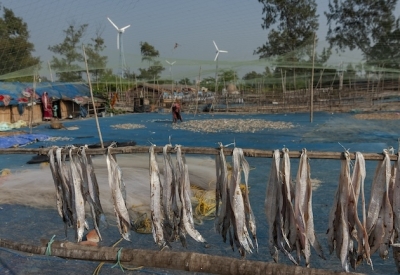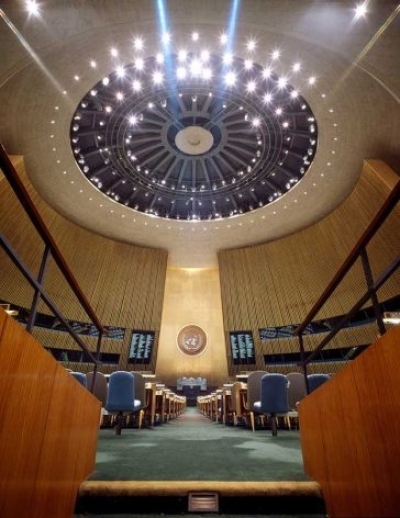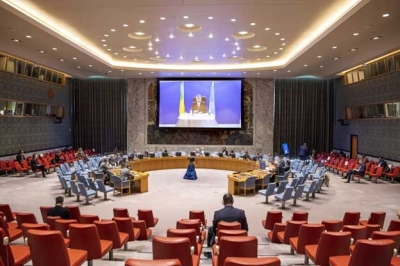Mass evacuation orders issued by the Israeli military to the people of Gaza continue to push them “into ever smaller areas” amid “ever-intensifying violence” in likely violation of international humanitarian law, the UN human rights office, OHCHR, said on Friday.
The OHCHR warning came nearly four months into the war which has seen widespread Israeli bombardment of the Gaza Strip, in response to Hamas-led attacks on Israeli communities beginning 7 October in which some 1,200 people were massacred and more than 250 taken hostage.
“Attacks on hospitals, schools, and other places of refuge have repeatedly displaced Palestinians into ever smaller areas, with ever-decreasing access to the essentials needed to sustain life,” said Ajith Sunghay, Head of the UN Human Rights Office for the Occupied Palestinian Territory. “Such a failure violates Israel’s obligations under international law.”
No ‘safe’ space
Mr. Sunghay told journalists in Geneva that Israeli Defense Forces (IDF) shelling had continued in areas “unilaterally designated” as “safe” including Al Mawasi in western Khan Younis.
DrTedros “Even after explosions were reported in Al Mawasi on 22 and 23 January, the IDF continued to order residents of western Khan Younis to move there,” he maintained.
That order was reissued “repeatedly” on 23, 24 and 25 January and reportedly impacted more than half a million people as well as three hospitals which have been under heavy attacks and siege — Nasser Hospital, Al Amal Hospital and the Jordanian Field Hospital — Mr. Sunghay continued.
“I have very grave concerns that these chaotic and mass evacuation orders are ineffective in ensuring the safety of Palestinian civilians, instead placing them in increasingly vulnerable, dangerous, situations.”
Health under attack
Amid Israeli airstrikes and street-to-street fighting between IDF soldiers and Palestinian armed groups, the UN World Health Organization (WHO) also reiterated serious concerns for healthcare workers and patients caught up in the violence.
Since war erupted in Gaza there have been 318 attackson healthcare in the enclave causing 615 fatalities and 778 injuries, latest WHO data indicates. The violence has impacted 95 healthcare facilities and only 14 hospitals out of 36 still function — seven in the south and seven in the north.
Latest data from Gaza’s health authorities cited by WHO reports that more than 26,000 people have been killed, a full 75 per cent children and women. There have been at least 60,000 registered injuries, but over 8,000 people are missing presumed dead under the rubble, said WHO spokesperson Christian Lindmeier.
“The few functioning hospitals in Gaza are in absolutely dire circumstances,” he added, noting that the hostilities had prevented access for patients and supplies many times.
Dread of not knowing
“(It’s) like in Nasser hospital right now; people shelter in the area outside under attack, the hospital is basically under siege, nobody can go in, nobody can go out, people not knowing what the next minutes will bring, fearing for their lives,” the WHO spokesperson said.
“As they are in a hospital it should be a refuge for those seeking help, for those injured, for those wounded, for those with diseases.”
In parallel with the violence impacting healthcare in Gaza, the WHO spokesperson noted spiking attacks on healthcare in the West Bank, where there have been 358 attacks in the West Bank resulting in seven fatalities and 59 injuries – more than in Gaza . “The attacks have affected 44 health facilities, including 15 mobile clinics and 245 ambulances,” WHO said in a situation update.
Desperation in Khan Younis, Rafah
Meanwhile, in the southern Gazan city of Khan Younis, OHCHR officer Mr. Sunghay described scenes of desperation that risked spilling over.
“I met with people who were frustrated, angry and understandably wary… their schools have been destroyed, as have their universities, destroying their hopes for the future,” he said.
Speaking from Amman, Jordan, the OHCHR officer noted that “near-continuous attacks” in recent days have not spared medical facilities and schools in Khan Younis, nor UN facilities and residential areas.
OHCHR and partners also remain seriously concerned about the situation in Rafah, in the far south of the Strip. “I saw displaced people who had been ordered by Israeli authorities to leave their homes, with no provision for their accommodation, literally living on the street, with sewage running in the streets and conditions of desperation conducive to a complete breakdown in order,” Mr. Sunghay said.
“The people I spoke to fear the extreme violence is spilling into Rafah – which will have catastrophic implications for the more than 1.3 million people already crowded there.”





